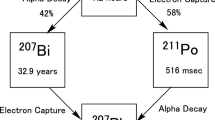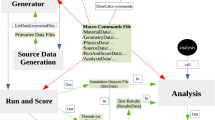Abstract
Purpose
Internal radiation dose calculations are normally carried out using the Medical Internal Radiation Dose (MIRD) schema. This requires residence times of radiopharmaceutical activity and S-values for all organs of interest. Residence times can be obtained by quantitative nuclear imaging modalities. For dealing with S-values, the freeware packages MIRDOSE and, more recently, OLINDA/EXM are available. However, these software packages do not calculate residence times from image data.
Methods and results
For this purpose, we developed an IDL-based software package for integrated data processing for internal dose assessment in nuclear medicine (SPRIND). SPRIND allows reading and viewing of planar whole-body scintigrams. Organ and background regions of interest (ROIs) can be drawn and are automatically mirrored from the anterior to the posterior view. ROI statistics are used to obtain anterior-posterior averaged counts for each organ, corrected for background activity and attenuation. Residence times for each organ are calculated based on effective decay. The total body biological half-time is calculated for use in the voiding bladder model. Red bone marrow absorbed dose can be calculated using bone regions in the scintigrams or by a blood-derived method. Finally, the results are written to a file in MIRDOSE-OLINDA/EXM format. Using scintigrams in DICOM, the complete analysis is gamma camera vendor independent, and can be performed on any computer using an IDL virtual machine.
Conclusion
SPRIND is an easy-to-use software package for radiation dose assessment studies. It has made these studies less time consuming and less error prone.




Similar content being viewed by others
References
Loevinger R, Budinger T, Watson E. MIRD primer for absorbed dose calculations. New York: Society of Nuclear Medicine; 1988.
Stabin MG. MIRDOSE: personal computer software for internal dose asssessment in nuclear medicine. J Nucl Med 1996;37:538–46.
Stabin MG, Sparks RB. Olinda—PC-based software for biokinetic analysis and internal dose calculations in nuclear medicine. J Nucl Med 2003;44:103P.
Postema EJ, Börjesson PKE, Buijs WCAM, Roos JC, Marres HAM, Boerman OC, et al. Dosimetric analysis of radioimmunotherapy with 186Re-labeled bivatuzumab in patients with head and neck cancer. J Nucl Med 2003;44:1690–9.
Stabin MG, da Luz CQPL. New decay data for internal and extrernal dose assessment. Health Phys 2002;83(4):471–75.
International Commission on Radiological Protection. Report of the task group on reference man, ICRP publication 23. New York: Pergamon Press; 1975. pp. 89–91.
Shen S, DeNardo GL, Sgouros G, O’Donnell RT, DeNardo SJ. Practical determination of patient-specific marrow dose using radioactivity concentration in blood and body. J Nucl Med 1999;40:2102–6.
Brown E, Hopper J, Hodges JL, Bradley B, Wennesland R, Yamauchi H. Red cell, plasma, and blood volume in the healthy women measured by radiochromium cell-labeling and hematocrit. J Clin Invest 1962;41:2182–90.
Wennesland R, Brown E, Hopper J, Hodges JL, Guttentag OE, Scott KG, et al. Red cell, plasma and blood volume in healthy men measured by radiochromium (Cr51) cell tagging and hematocrit: influence of age, somatotype and habits of physical activity on the variance after regression of volumes to height and weight combined. J Clin Invest 1959;38:1065–77.
Thomas SR, Maxon HR, Kereiakes JG. In vivo quantitation of lesion radioactivity using external counting methods. Med Phys 1976;3:253–5.
Buijs WCAM, Siegel JA, Boerman OC, Corstens FHM. Absolute organ activity estimated by five different methods of background correction. J Nucl Med 1998;39:2167–72.
Snyder WS, Ford MR, Warner GG, Watson SB. ‘S’, Absorbed dose per unit cumulated activity for selected radionuclides and organs. MIRD pamphlet 11. New York, NY: Society of Nuclear Medicine; 1975.
Weber D, Eckerman KF, Dillman LT, Ryman J. MIRD: radionuclide data and decay schemes. New York: Society of Nuclear Medicine; 1989.
Eckerman KF, Stabin MG. Electron absorbed fractions and dose conversion factors for marrow and bone by skeletal regions. Health Phys 2000;78:199–214.
Sgouros G. Bone marrow dosimetry for radioimmunotherapy: theoretical considerations. J Nucl Med 1993;34:689–94.
Siegel JA, Thomas SR, Stubbs JB, Stabin MG, Hays MT, Koral KF, et al. MIRD pamplet no. 16: techniques for quantitative radiopharmaceutical biodistribution data acquisition and analysis for use in human radiation dose estimates. J Nucl Med 1999;40:37S–61S.
Erwin WD, Groch MW, Macey DJ, DeNardo GL, DeNardo SJ, Shen S. A radioimmunoimaging and MIRD dosimetry treatment planning program for radioimmunotherapy. Nucl Med Biol 1996;23:525–32.
Liu A, Williams LE, Lopatin G, Yamauchi DM, Wong JY, Raubitschek AA. A radionuclide therapy treatment planning and dose estimation system. J Nucl Med 1999;40:1151–3.
Sjögreen K, Ljungberg M, Strand SE. An activity quantification method based on registration of CT and whole-body scintillation camera images, with application to 131I. J Nucl Med 2002;43:972–82.
McKay E. A software tool for specifying voxel models for dosimetry estimation. Cancer Biother Radiopharm 2003;18:61–9.
Glatting G, Landmann M, Kull Th, Wunderlich A, Blumstein NM, Buck AK, et al. Internal radionuclide therapy: the ULMDOS software for treatment planning. Med Phys 2005;32:2399–405.
Author information
Authors and Affiliations
Corresponding author
Rights and permissions
About this article
Cite this article
Visser, E., Postema, E., Boerman, O. et al. Software package for integrated data processing for internal dose assessment in nuclear medicine (SPRIND). Eur J Nucl Med Mol Imaging 34, 413–421 (2007). https://doi.org/10.1007/s00259-006-0226-z
Received:
Accepted:
Published:
Issue Date:
DOI: https://doi.org/10.1007/s00259-006-0226-z




